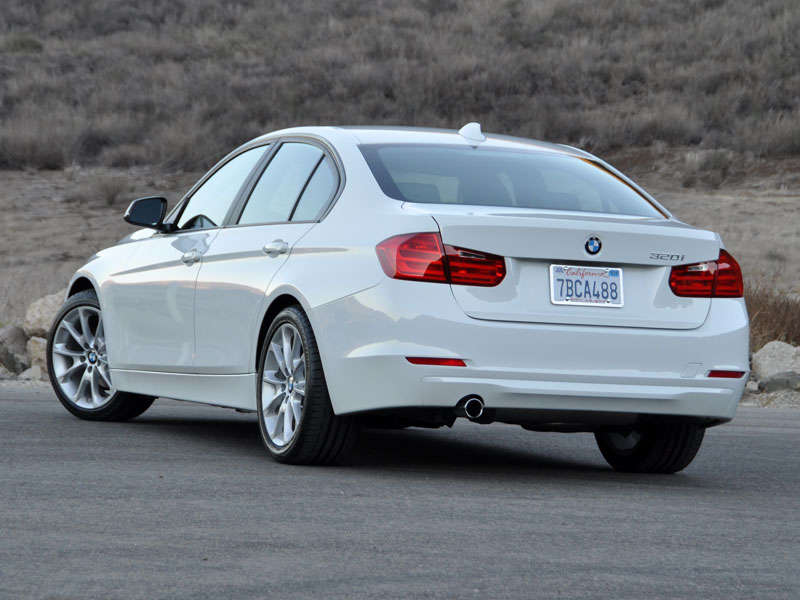Recent Articles
Popular Makes
Body Types
2014 BMW 320i Review and Quick Spin

As a kid growing up in Michigan back in the 1980s, my vision of future success was a house in California with a palm tree in the front yard, a swimming pool in the back yard, a couple of kids running around, and a new BMW 3 Series parked in the driveway.
Fast-forward 30 years, and I’m writing this review of the 2014 BMW 320i from my house near Los Angeles, which has a towering palm throwing shade on the front grass, a swimming pool in the back, and a couple of kids running around in 80-degree winter heat, almost certainly doing something they ought not be. And while I fell in love with Miatas along my path from Detroit to L.A., as 2013 closes out and we ring in the New Year, an Alpine White 320i sits in the driveway. Life is good.
Of course, other than the children, I know better than to think any of these things really matters in terms of happiness or success. Nevertheless, they are appealing accouterments to a life spent, thus far, pursuing passion, and while the BMW isn’t my own, I sure do recommend it to my fellow car enthusiasts. A 320i might not be the most powerful 3 Series, but at $33,675, it is a genuine German sport sedan bargain.
You’ll notice that I did not call it a luxury sports sedan. That’s because it isn’t one. Not this stripped-down example, anyway.
2014 BMW 320i Review and Quick Spin: About Our Test Car
A long time ago, I served as the editor of Edmunds.com, where we always purchased our own long-term test cars, which were passed around to members of the staff and their families in order to report on how satisfying, reliable, and cost-effective the vehicles were over the course of two years and multiple drivers. When the E46 3 Series debuted in the U.S. for the 1999 model year, the editorial team decided to get one, special ordered as a 330i with a manual gearbox, metallic paint, a Sport Package, and a navigation system. Because our order lacked the usual goodies people wanted in a 3 Series, like an automatic transmission, leather seats, a premium sound system, and more, the dealership demanded a huge deposit just in case we flaked out on delivery and it was stuck trying to sell such an unappealing vehicle.
My 2014 BMW 320i test was similarly basic in nature, a vehicle that might be hard to find in a dealership’s existing inventory, and for that I adored it. Aside from a Sport Package containing 18-inch light alloy wheels with staggered width performance tires, a sport suspension, sport seats, an M sport steering wheel, and a dark-colored headliner, it had no options. The price tag was $34,975, and according to BMW I could sign a lease for this exact vehicle for less than $355 per month for 36 months, as long as I put $3,325 down and didn’t drive it more than 10,000 miles per year. (That low lease mileage limit utterly negates the whole point of buying a BMW in the first place, but I digress.)
A price of less than $400 per month sure is tempting, especially now that I’ve got kids, and only because I like BMWs for their driving characteristics rather than their ability to coddle occupants or convey success. Still, that price tag remains lofty compared to, say, a completely loaded 2014 Mazda 6 or even a maxxed-out 2014 Volkswagen Jetta GLI. And that BMW lease doesn’t leave much margin for error in terms of monthly mileage limits. So, since I’ve got college edumacations to pay for, and a retirement to plan for, maybe a 320i doesn’t make good financial sense even when it’s got almost no options, and even though it is quite good to drive.
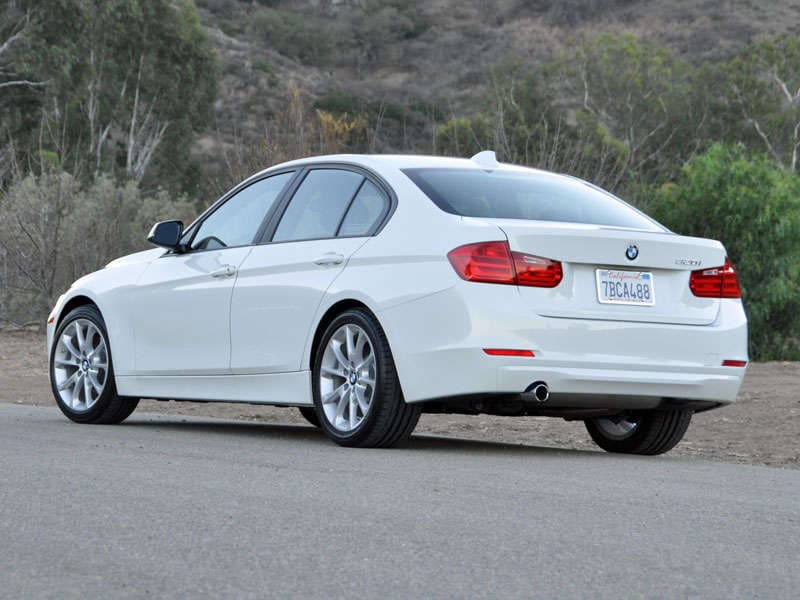
2014 BMW 320i Review and Quick Spin: Styling and Design
Among BMWs, the 3 Series is the most appealing, to my eye. The company knows not to screw a good thing up, so it typically experiments with wilder styling ideas on lower-volume vehicles in order to take the public’s temperature, perhaps most famously with the “Bangle-butted” 2002 BMW 7 Series and the “flame-surfaced” 2004 BMW Z4. Comparatively speaking, modern BMWs retain elements of each of these iconic designs, but the company has taken a more conservative approach with its latest offerings and, as a result, most contemporary Bimmers are visually appealing if not extravagant departures from the status quo.
This refrigerator-white 320i test car is no different, and the staggered-width 18-inch wheels really help to give it a proper stance. During my photo shoot at a local park, a couple of young guys wanted to know why I was planning to sell such a great looking, and obviously new, BMW. After explaining why I had the car, and telling them about the lease deals, the guy pointed to his ratted-out Mk IV GTI and said: “I pay $290 a month for that thing. Four payments left. Maybe I’ll get one of these instead. I had no idea they were so cheap.”
Of course, I probably should have talked to him about lease contract employment requirements, creditworthiness issues, insurance costs, and other factors that make a new 3 Series not-so-cheap, but the daylight was fading and I needed to shoot pictures. Sorry that you might need to crush a dream, Steve Thomas BMW.
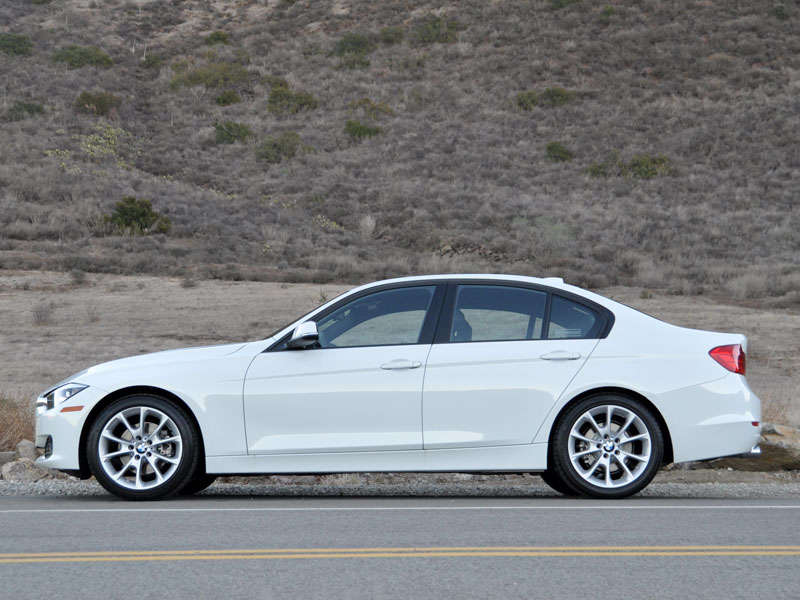
2014 BMW 320i Review and Quick Spin: Comfort and Quality
Given that a 320i is the least expensive BMW you can buy, you might not expect high levels of comfort and of quality, especially in light of the fact that it isn’t a real luxury car. Thankfully, this is not true. I found the 320i’s bits and pieces to reflect typically high levels of German engineering and precision, exuding characteristics of quality and, in most cases, refinement.
My test vehicle’s 10-way manually adjustable front sport seats offered extending thigh bolsters combined with cushion height and cushion tilt adjusters. As an unexpected extra, these sports seats offer power adjustable side bolsters to help them fit a variety of body types. Wrapped in SensaTec leatherette that proved soft, pliable, and great at retaining body heat, the 320i’s front seats were quite comfortable, and I thoroughly enjoyed the leather-wrapped M sport steering wheel. Carmakers often forget that the steering wheel is one of the most frequently touched parts of the car, but not BMW, and this one is a genuine joy to hold.
The rear seat is remarkably comfortable for me, and I’m six feet tall and pushing a holiday-enhanced 250 pounds. Thigh and outside bolster support is excellent, air vents help keep passengers cozy or cool, and I had just enough knee room in front of hard plastic front seatbacks for my rather long legs. My size-12 feet fit under the front seats without drama, and while it was evident upon exit that I really ought to spend more time at the gym, I’m not gonna ding BMW for my lack of abdominal muscles.
Rather, I’ll complain about how tough it was for my kindergartener to buckle up while sitting in her booster seat. The outboard rear seat belt latches are nestled tight into their recesses, making it difficult, and often impossible, for her to accomplish a solid click on her own. It was even tough for my wife and I to simultaneously lean across her, pull the left rear part of her booster seat’s base forward, and then get the seat belt properly latched.
As for cargo space, the 320i’s trunk measures on the small side at 13 cu.-ft., but it is worth noting that the cube-shaped space is easy to pack and functional. If you want to carry more than the trunk can hold, you’ll need the optional split-folding rear seat, which costs an extra $475. Or you’ll need to buy a 328i Sport Wagon, which provides up to 53 cu.-ft. of cargo space for a base price of $42,375.
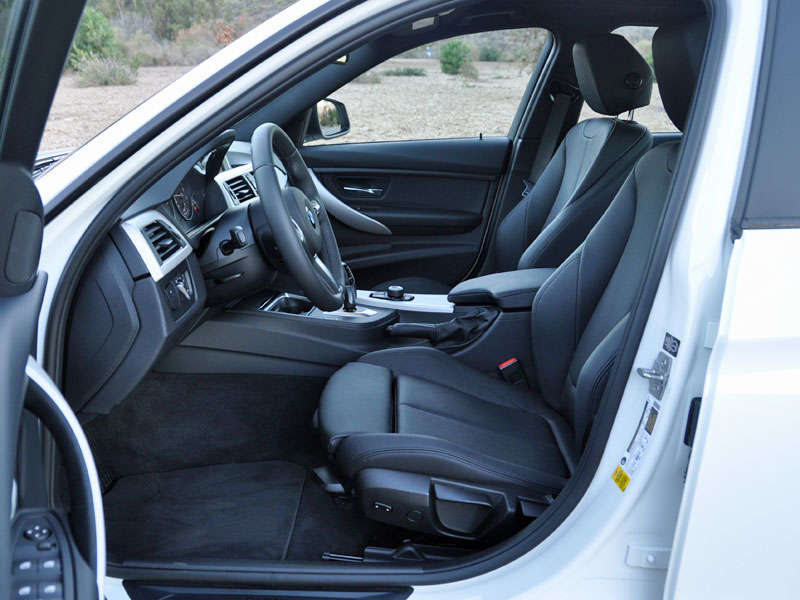
2014 BMW 320i Review and Quick Spin: Features and Controls
I prefer simpler BMWs to complex BMWs, though I will qualify that statement by acknowledging that the company has dramatically improved the displays and intuitiveness of the latest iDrive screens. Still, I’d rather drive a stripped-down 320i any day, avoiding unnecessary distractions and enjoying the trip to my destination as much as I might the destination itself.
Without options, this particular 320i was refreshingly easy to use. The only thing missing, an item that could have made it almost ergonomically perfect, was a tuning knob for the radio. There is one embedded into the basic iDrive system. Push the main menu button on the center console, select “Radio,” click a couple of times, and the iDrive controller turns into a big, manual tuning knob. Still, a regular old tuning knob would have been terrific.
Another irritant is the BMW’s center-return turn signal stalk. For whatever reason, this design is becoming more common in modern cars, and I’m getting used to them. For example, during my one-week test of the 320i, I only mistakenly turned on the opposite signal a single time while trying to turn off the selected signal. If you’ve ever been driving down the freeway, and you’ve seen a BMW with what appears to be schizophrenic signaling behavior, now you know what’s going on behind that car’s wheel.
Additionally, and this is a teensy-eensy-weensy little gripe, with the driver’s seat and steering wheel set to my preferences, I could not read the bottom line of the gauge cluster’s lower information display, which shows outside temperature, the odometer reading, and the trip odometer reading. Of greater concern is that I often wondered if the car was really turned off after coming to a stop, placing the transmission in Park, and then pushing the stop/start button. That’s because the automatic stop/start system often engaged before I pushed the button, but the radio stayed on after I pushed the button. On at least one occasion, the car was already off, and I accidentally restarted the engine. A big “Engine Off” warning on the display screen would resolve this, shown only when the car is in Park, of course.

2014 BMW 320i Review and Quick Spin: Matters of Safety
If you’re seeking a car equipped with lots of safety technology, the BMW 320i is likely to disappoint. If you’re like me, though, and you’d rather not deal with the irritation associated with a bunch of warning lights flashing and chimes dinging at you, you’ll appreciate that BMW supplies a car offering the essentials, and little more.
Standard equipment includes eight airbags, rain-sensing wipers, automatic headlights, and a free 10-year subscription to BMW Assist eCall with Automatic Collision Notification and an SOS Emergency Request button. If you’d like, BMW will install a reversing camera and parking assist sensors at extra cost. If you want features such as a blind-spot information system, automatic high-beam headlights, or adaptive cruise control, you’ll need to buy a more powerful and expensive 328i.
In crash-tests performed by the National Highway Traffic Safety Administration (NHTSA), the 3 Series earns a 5-star overall safety rating, receiving 5-star ratings across the board except with regard to the driver’s side in a frontal-impact crash. In this test, the car gets a 4-star rating.
A 3 Series driver is also at greater risk of injury according to the Insurance Institute for Highway Safety (IIHS). The IIHS gives the car its top rating of “Good” combined with a “Basic” rating for its optional crash avoidance technology. However, a “Marginal” rating in the small overlap frontal-impact test means this BMW can’t be named a “Top Safety Pick” for 2014.
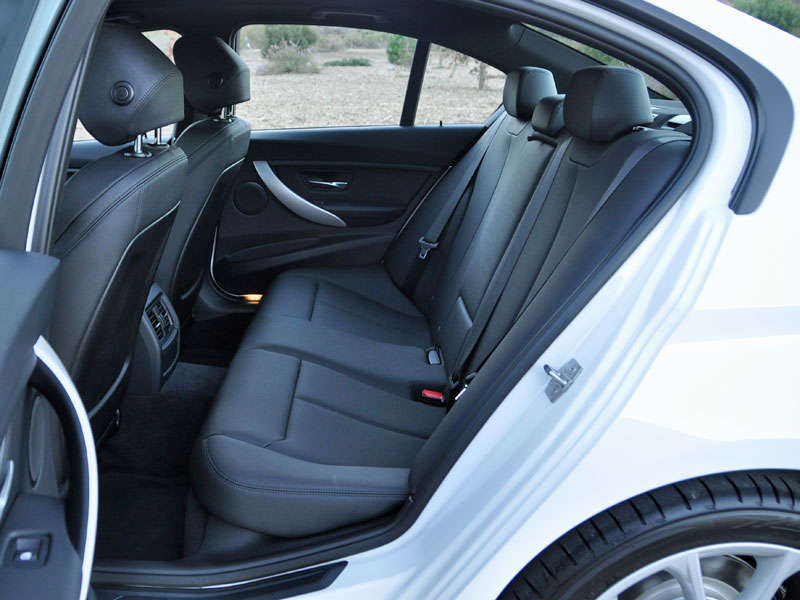
2014 BMW 320i Review and Quick Spin: Driving Impressions
Right up front, I’ll tell you that the 320i is more rewarding to drive than you might expect based on the engine’s power ratings, but the trick is to A.) Buy the Sport Package and B.) Learn how to use the transmission.
Like the more expensive BMW 328i, the BMW 320i is equipped with a turbocharged, direct-injected 2.0-liter 4-cylinder engine, but it isn’t nearly as powerful as the one installed in the 328i. In this application, it makes 180 horsepower from 5,000 rpm to 6,250 rpm (60 less than the 328i) and 184 lb.-ft. of torque from 1,250 rpm to 4,500 rpm (71 lb.-ft. less than the 328i). Nevertheless, the automaker quotes a BMW 320i acceleration time to 60 mph of just 7.1 seconds, whether the car is equipped with the standard 8-speed automatic transmission or the no-charge optional 6-speed manual gearbox.
Granted, that’s not fast, but neither is it slow, and during my time with the 320i, it felt sluggish only under certain driving conditions with the Eco Pro mode engaged. Eco Pro is a part of the standard Driving Dynamics Control system, which also provides Comfort and Sport driving modes and the ability to manually shift gears using the selector. Generally, I used Eco Pro on the freeway and country highways, I used Comfort for driving around town, and I used Sport when slamming down some of my favorite local roads in the hills above Malibu. Briefly, I tried the manual shift mode, but the pattern is counterintuitive to me, so I didn’t like it.
My test car had rear-wheel drive, but BMW offers its xDrive all-wheel-drive system with this engine. Driving purists may cringe, but a 320i with an automatic is better balanced than a 320i with a stick: 49.9%/50.1% front-to-rear weight distribution compared to 50.5%/49.5%. In case you’re wondering, the engine requires premium fuel and is rated to get 28 mpg in combined driving. I averaged 27.5 mpg.
When driving on the highway, I found the Eco Pro setting relatively easy to override by applying extra aggression to the accelerator pedal. If you forget you’re in this mode, and you want to switch lanes to pass someone on the freeway, you’re going to notice a delay in powertrain response that causes momentary concern. Don’t worry, just push harder with your right foot.
Select Sport mode by pushing the gear selector to the left of center. This setting provides far livelier powertrain calibration, keeping the revs higher and increasing accelerator and transmission responsiveness, making Sport model most appropriate for exploring the 320i’s dynamic potential. Otherwise, this mode serves to cancel the automatic stop/start system, which some people might prefer, and to consume extra fuel.
Not surprisingly, then, during most of the miles that I covered in the 320i the Driving Dynamics Control system was placed in Comfort mode, which turns out to be a good blend of Eco Pro and Sport modes. The automatic stop/start system remains on duty, saving gas while the car is idling in traffic or at an intersection, yet keeps the car ready to respond when the driver demands extra power.
Once I got into the habit of adjusting the 320i’s Driving Dynamics Control system to specific driving conditions, I found this entry-level 3 Series predictable and satisfying to drive. The electric steering assist feels too light when shuffle-steering through a set of S-curves at twice the speed limit, but that thick-rimmed steering wheel and smooth leather sure help make up for it. In other driving conditions, I found the steering to be quite good for an electric setup.
With the optional Sport Package, the 320i is equipped with an M sport suspension and more aggressive tires, and that translates to a firmer ride combined with better handling. The car isn’t exactly stiff, though, retaining an ability to absorb most road surface abnormalities while at the same time clearly communicating road texture through aural and tactile cues.
The 320i’s standard performance 4-wheel-disc braking system includes Brake Fade Compensation, Brake Drying, Dynamic Brake Control, and Cornering Brake Control. As expected, the pedal feels terrific underfoot and proves easy to modulate, and on a surprisingly warm 80-degree winter’s day they resisted fade during miles of downhill abuse on a writhing road.
If there’s anything off-putting about the 320i’s hardware package, it’s that when the engine is at idle, it sounds like a diesel clackety-clacking from under the hood. And from the outside, it sounds even louder. Also, BMW’s automatic stop/start system isn’t terribly refined. When the engine shuts down, the driver is aware of it due to the absence of diesel-style clatter and a small vibration. As the engine re-starts, the 320i shudders as the starter whirs and the engine comes to life.

Photo by BMW
2014 BMW 320i Review and Quick Spin: Final Thoughts
There are a few important points to make about the BMW 320i. First, if you’re a driving enthusiast, there’s not much reason to pay more for a 328i or 335i unless you’re the type to suffer from badge envy. Yes, those models are faster, but the 320i is a terrific car to drive, superbly accomplished in almost every respect once you’ve figured out how to use Driving Dynamics Control to your advantage.
Second, the BMW 320i isn’t a luxury car. Sure, you can turn it into one by ordering a whole bunch of extras and upgrades, but then the price tag skyrockets to $46,000. As tested for this review, equipped with nothing but a Sport Package, the premium paid over mainstream models is clearly poured into superior engineering and quality materials.
Third, the fact that BMW supplies buyers with such a range of choice is one of the most appealing aspects of the 3 Series. You can choose basic or luxurious, fuel-efficient or powerful, gasoline or diesel, rear-wheel or all-wheel drive, and sedan or station wagon body styles.
As for me, having spent a week with the BMW 320i, I know which one I would buy. Then again, there is that new 328d diesel version, and for just $5,850 more. Decisions, decisions.
BMW provided the 2014 320i for this review
2014 BMW 320i Sedan photos by Christian Wardlaw
